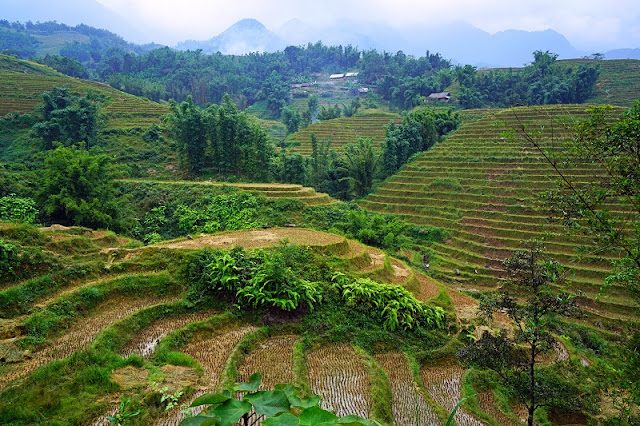‘September,’ the bright green rice terraces slowly lose their verdancy; the amber signs of the impending rice harvest blanketing the hills. The slopes glow sun-kissed yellow as ripened rice ears burst with kernels. I have seen the photographs on the internet and the view is indeed spectacular…
>>> GET FREE ITINERARY PLANNING FOR SAPA TRIP <<<
 |
| Photo by Andrey Sulitskiy |
I visited Sapa in early June at the start of the rice planting season, just after the winter chill retired from the mountains. Rice needs warmth and plenty of water to guarantee a good crop and in this mountainous area of Vietnam, winters are too cold. Unlike Central and Southern Vietnam, where the temperature allows several harvests a year, in the cooler hills of Sapa, there is only opportunity for a single harvest each year. Enough rice to feed the local population as families grow their own on family-sized plots, but scarcely enough to take to markets or wholesalers and sell on.
 |
| Photo by Vietnam Typical Tours |
I may not have seen Sapa in all its golden glory, but the sea of greenery made an equally riveting scene. With warmer days ahead and plenty of heavy, revitalising summer downpours on the horizon, the rice terraces were brimming with activity at the beginning of a new rice season. The day before my arrival, Sapa had been drenched by heavy showers making the hiking trails extremely slippery and treacherous.
 |
| Photo by Vietnam Typical Tours |
Probably not ideal for the tourists and hikers in the area, but a definite boon for farmers and locals who depend on the rain to get the season off to a good start. Add to this the arrival of the summer holidays for kids, plenty of hands about to put the seedlings carefully and meticulously, one by one, into the muddy and water-filled paddies. And it was muddy!! Having tried a bit of rice planting myself, almost knee-deep in the squelchy slush, it is back-breaking and monotonous work under a blazing sun.
 |
| Photo by Vietnam Typical Tours |
Whereas in the flatter low-lying areas of Vietnam, many facets of the rice growing cycle have become more mechanized, in Sapa age old traditions still survive. As the rice in and around Sapa is grown on steeper hill flanks, only small machinery can be used to prepare the paddies and help with the harvest. Most of the work is still done by hand, laboriously and intensively. Farmers not only tend to the crops, they also need to look after the banks that separate the many rice terraces and keep the tender rice plants in their pools of water. Crumbling or collapsed banks are easily strengthened and repaired using strong and flexible bamboo canes which are found in abundance in the area.
 |
| Photo by Vietnam Typical Tours |
Life in the Sapa hills is simple and largely self-sustaining as households still make ample use of nature’s resources for food, clothing and shelter. Many of Vietnam’s ethnic minorities live in the mountainous regions, their traditional clothing, lifestyle and culture attracting as much attention as the ever-changing hues of the rice terraces.
Rice and corn are the main staples whilst buffalo, pigs and chickens provide additional protein. Traditional dwellings are built using wood; clothes are fashioned using the fibres and dye from locally grown plants.
